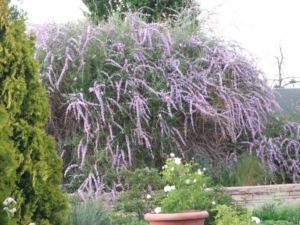Choosing a Pot for Your Container Garden
Finding the Perfect Pot
by Chris McLaughlin
Whether you’re growing flowers, vegetables, herbs, shrubs, or small trees, container gardening has made a big comeback and in my opinion, it’s a trend that’s here to stay. These mini-gardens are fast, simple, versatile, and beautiful which makes them popular with all gardeners; no matter how much space they have to work with.
The real challenge comes when you’re choosing a pot for your container garden, standing in the center of a virtual sea of pots and containers — how do you decide which ones to bring home? Well, truthfully, that answer lies with you and your plants. There are pros and cons to everything, so here’s the low-down on the various container materials so that you can decide which is the perfect pot.
Terra-cotta — Probably the most well-known and well-used type of container anywhere, it’s produced in an endless variety of shapes, sizes, and styles. Terra-cotta is also less expensive than many other containers. Make sure a terra-cotta container is frost resistant (check for labeling); otherwise, it could crack during the cold months. Be aware that terra-cotta tends to dry out faster than most other planting containers.
Plastic — Plastic is rather a win-win. It’s nonporous, so the soil tends to stay moist longer than in terra-cotta. These containers are also lightweight and therefore very easy to move around, even after being filled with soil and planted. However, you may have to really look around to find one that’s honestly attractive.
Wood — Wood is a great material that looks natural with vegetable plantings. There are small tubs, half-barrels, and troughs made of wood. They’re typically not expensive, with the exception of the monster-sized half-barrels. I tend to like wood containers because I can paint them any color I want, year after year. They can also be varnished to help prolong their lives.
Glazed Stoneware — I love the glazed stoneware pots for both ornamentals and vegetables. They’re usually quite frost resistant and come in lovely shades. Typically the glazed pots are a basic round or square-shaped container, but I’ve seen them in other shapes, as well. Because they’re glazed, they hold in that precious moisture much better than terra-cotta.
Fiberglass — Fiberglass containers also hold moisture well and their light weight makes them extremely easy to move around. Generally, they’re shaped like other, more pricey containers (glazed, copper, stone, etc)[md]which is a plus, aesthetically. The only downside is that they break or crack easier than the more expensive ones.
Metal — This includes those containers made of copper and galvanized steel, too. Although it can be perfect for the right setting, pure metal is quite contemporary and isn’t “warm” enough for me. If contemporary describes the style of your balcony or porch, it may be the right choice for you. Be careful, though. Roots will warm up extremely fast in this type of container and will freeze just as quickly in the winter.
Concrete and Stone — Natural stone and even concrete containers can be beautiful and house vegetables nicely
. These are probably the most expensive type of containers to purchase. The only drawback is that, once they’re filled with soil, planted, and then watered, you won’t want to move them. So find a nice little spot for them to live for the entire season.
Recycled Containers — Nearly anything is fair game when looking for a container to recycle as a planter. All they need to have is drainage holes. Old wheelbarrows, shoes, plastic cat-litter containers, rusty buckets, tool boxes, BBQs, bicycle baskets, Easter baskets, and the kitchen sink are all fair game.
Local home-improvement centers, garden centers, and nurseries will have most of the container types below. But the smaller, independent shops will have some of the more original and fabulous gems.



